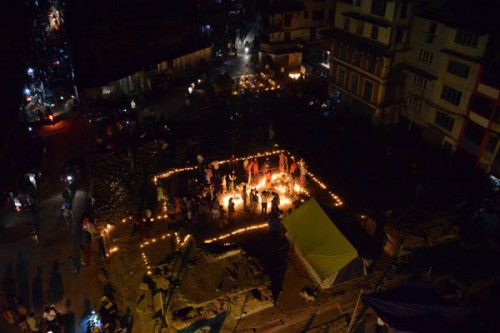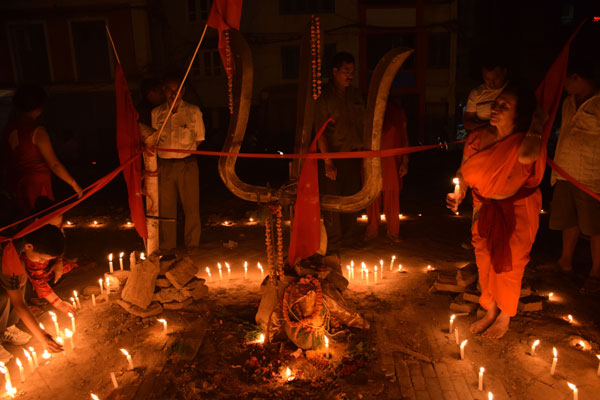
This blog entry honoring Nepal one year after the nation’s devastating earthquakes is written by Dominique Townsend, Assistant Director of Interpretation and Development at the Rubin Museum.
This week, we are reflecting on empathy at the Rubin Museum. Practicing empathy gives us the chance to relate deeply to other people, whether it be our friends and family or whether it be the people affected by last year’s earthquakes and the aftermath in Nepal. Empathy can expand our experience and raise our awareness to our good fortune as well as strengthen our connections to others, near and far. It can extend our sense of what it is to be human. At the Rubin, we’ll be thinking about the people of Nepal, and we hope you will too.
Remembering the day of the first earthquake
All of us who work at the Rubin Museum likely remember exactly where we were when we heard or read the news about the earthquake that rocked Nepal one year ago next week. I was making breakfast for my young son and coffee for myself on a beautiful April morning when I glanced at my phone and saw the news of disaster streaming in on Twitter.
Nepal has regular seismic activity and tremors are part of daily life there. But by last year, the “big one” in Nepal was long overdue by most estimates. Many experts had predicted that because of the dense population and loose or non-existent safety measures in building and infrastructure, the loss of lives feasibly could be more than 100,000. When I first saw the news, I feared the worst. Luckily for me, I was able quickly to determine through the grapevine of social media that my close friends in Kathmandu were alive. However, it was clear that many other people were not as fortunate, as the death toll rose and reports of entire villages being destroyed emerged.
A people and culture in danger

Many of the finest artworks in the Rubin Museum’s collection were made in Nepal, and we regularly engage with Nepalese people and culture through our Family Programs, Himalayan Heritage Meet-ups, exhibitions, and theater programs. Since we are dedicated to opening visitors’ minds to the art and ideas of Himalayan cultures, Nepal is literally and figuratively at the center of our daily work. It’s impossible to think of Nepal without thinking of its vibrant culture and its famously exquisite art and architecture, particularly its religious art and its distinctive temples.
When the first of two major quakes were followed by what turned out to be hundreds of terrifying aftershocks, again and again we thought and grieved foremost for the people who had lost loved ones, limbs, and homes. And then we thought of the artistic and architectural treasures that had been damaged or lost and asked whether and how the country might recover. In the early days after the first quake on April 25, 2015, we at the Rubin organized efforts to honor Nepal. Now, one year later, it’s important that we recognize how much Nepal and its people still warrant our empathy and support.
The resilience of the Nepalese people

I lived in Kathmandu for five years, during my early twenties, and in many ways, it was where I became an adult. The pervasiveness of ritual in daily life, the blend of ancient art and architecture with contemporary global culture, and the extraordinary resilience and good humor of Nepalese people impressed me and shaped me in important ways. At the same time, Nepal’s well-being has been hindered by many long years of corruption and political instability among other factors. The ongoing impact of last year’s earthquakes has wreaked havoc during an already challenging historical period for Nepalis from all walks of life.
While living in Nepal, I volunteered at a center for homeless children and I was humbled deeply by their example. They were orphans who had to fend for themselves in a country that at the time had the lowest per capita income average in Asia. They had inconceivably little in a material sense, and yet they were exemplars of generosity and liveliness every day for me. I thought of those homeless kids first when the earthquake hit. And then I thought of the many other people whose homes and communities were leveled by the quakes. Unfortunately, many of them went on to spend a long winter in makeshift dwellings. Today many Nepalese people are still wading through the bureaucracy and inefficiency with little hope of getting official help in their efforts to rebuild their homes.
Honoring Nepal
I wish I could report great progress and rebuilding in Nepal since last year’s quakes. Most accounts show that in addition to the 8,000 lives that were lost, many people are still without homes although there has been some rebuilding in the major historic centers such as Bhaktapur. Fuel shortages and irregular electricity have made the situation all the more difficult.
Over the coming days and beyond, we at the Rubin invite you to honor Nepal through learning about the daily struggles that the Nepalese people face, as well as the rich culture and architecture that was lost in 2015 and remains at risk.
Engage with the Nepalese art and cultural heritage from our collection, learn how you can support rebuilding efforts, and join the many individuals and institutional partners who are raising awareness of Nepal’s cultural traditions by visiting our Honoring Nepal page.

